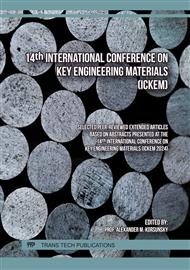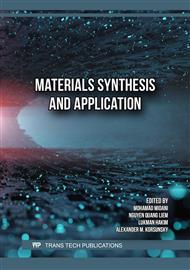p.25
p.33
p.43
p.53
p.75
p.83
p.95
p.113
p.123
Cost-Effective Hydrothermal Synthesis of Luminescent Carbon Dots from Date Palm Midrib
Abstract:
Nanocarbon synthesis from diverse sources has garnered significant attention, with a particular focus on materials derived from biomass. Carbon dots (CDs), due to their water solubility, low toxicity, and biocompatibility, have emerged as promising candidates for a wide range of applications. In recent years, CDs have found utility in several applications such as bioimaging, drug delivery, and biosensors. In this study, we present an eco-friendly, straightforward, and cost-effective technique for the synthesis of carbon dots through a hydrothermal reaction, utilizing peeled date palm midribs as the source material. High-resolution transmission electron microscopy, X-ray diffraction, UV-visible absorption spectroscopy, photoluminescence analysis, Fourier-transform infrared spectroscopy, and zeta potential measurements services to investigate the synthesized carbon dots' morphology, crystal and structure, and optical properties. The results show that the carbon dots had a size distribution ranging from 2.5 to 6 nm, and a crystallographic interplanar distance of 0.23 nm corresponding to the graphitic structure. When excited at a wavelength of 340 nm, the synthesized dots exhibited a prominent bluish emission at 420 nm, highlighting their potential for use in optical and biological applications. This work underscores the feasibility of harnessing sustainable biomass sources, such as date palm midribs, for the green synthesis of carbon dots with desirable properties, opening up new avenues for their utilization in cutting-edge technologies.
Info:
Periodical:
Pages:
75-80
Citation:
Online since:
August 2024
Authors:
Keywords:
Price:
Сopyright:
© 2024 Trans Tech Publications Ltd. All Rights Reserved
Share:
Citation:



